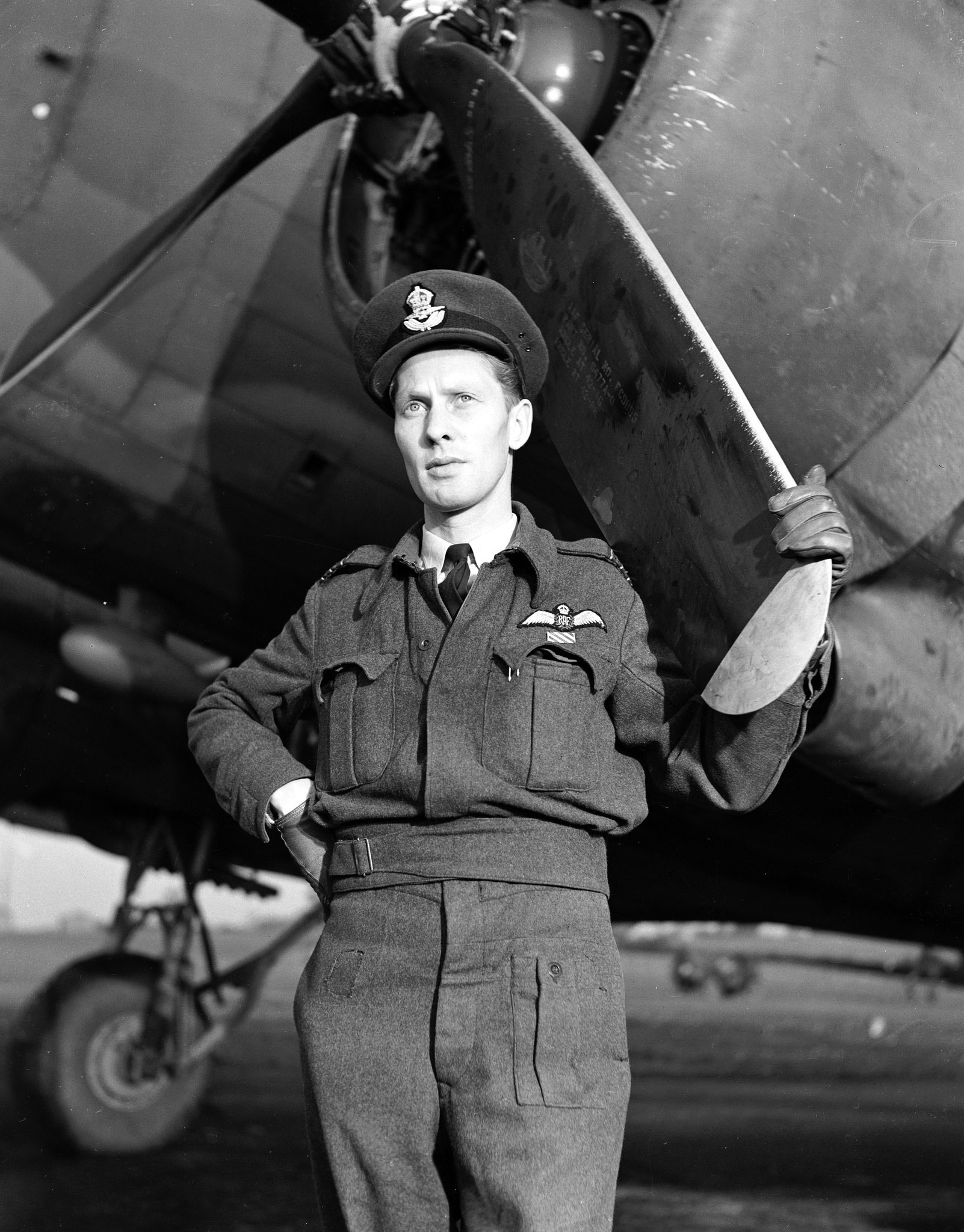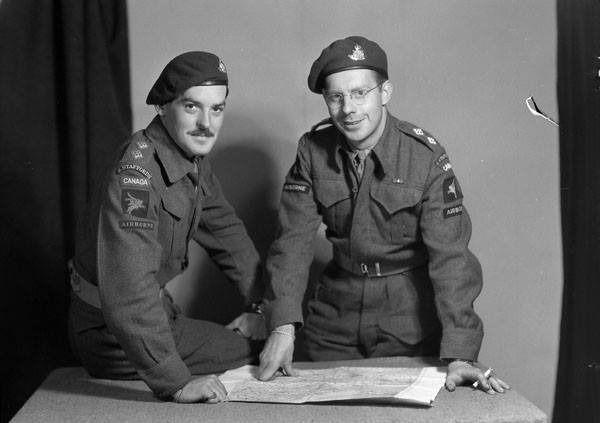
Wing Commander John A. Sproule, DFC of Toronto and Brandon, Man., commanding officer of the Royal Canadian Air Force’s 437 “Husky” Squadron. [Canadian Virtual War Museum]
With only nine No. 437 crews ready at the time of departure, combined with two extra crews seconded to the Canadian flyers, each Dakota aircraft towed Horsa gliders that in turn carried members of 1st British Airborne Division. Their planned drop zone was the Dutch city of Arnhem. Aside from a scattering of flak fire, they encountered little opposition. It was just the beginning.
Operation Market Garden was, in the eyes of British Field Marshal Bernard Montgomery, intended to be “one powerful and full-blooded thrust towards Berlin.” In creating a proposed corridor into Germany, the “Market” phase would involve a U.S.-British-Polish airborne force parachuting into occupied territory to establish various bridgeheads. British XXX Corps, earmarked for the “Garden” phase, would then drive its armour and infantry through these footholds to the farthest bridge at Arnhem over the Rhine River. From there, the Allies could push north of the German Ruhr as it smashed into the Fatherland.
The plan was ambitious—and would prove to be a bridge too far.
Of course, the men of 1st British Airborne Division (nicknamed the “Red Devils”) had no such concerns as they floated down from the heavens that sunny afternoon of Sept. 17. Landing some 12.8km to the west of their assigned objective, their numbers included, or would later include, around 20 Canloan officers either arriving that first day or during subsequent drops.
Canloan was an Anglo-Canadian program that had been established in the autumn of 1943, whereby 673 Canadian subalterns—junior officers between the ranks of lieutenant and captain—were seconded to British regiments amid the latter’s acute manpower crisis. Many were able to choose their battalions, but a proportion without any strong preference were instead assigned to the airborne.
Lieutenant Leo Heaps, on the other hand, was an airborne volunteer. The 21-year-old Winnipeg native, one of the few Canloan parachutists when most other officers belonged to glider-borne units, had never jumped out of an aircraft.
His landing through a cluster of pine trees was, suffice to say, rough. But the soldier of 1st Parachute Battalion soon dusted himself off and pushed on.
With no rank-appropriate positions available when he signed up, Heaps carried out special assignments at his will. The next day, he boarded a jeep laden with supplies, a wireless operator, and a Dutch guide bound for Arnhem bridge.
In a strange turn of events, the jeep never made it after the steering wheel came off and the trio crashed into an embankment. Miraculously unharmed, Heaps flagged down a Bren carrier and continued into the war-torn city, finding that British plans were already unravelling against vicious German resistance.
Back at the drop zone, 1st Air Landing Brigade—comprising the greatest concentration of Canloan officers—had been defending the area in preparation for a second lift. Over the night and into the early morning of Sept. 17-18, however, the men had come under attack and suffered heavy casualties.
Among the fatalities were 21-year-old Lieutenant Albert E. Kipping of Toronto and 27-year-old Lieutenant Albert E.F. Wayte of Montreal. Twenty-nine-year-old Montrealer Captain Basil W. H. Hingston was likewise killed on Sept. 19.

Only two CANLOAN officers of 20 that served at Arnhem managed to escape. Lieutenant W. Alex (“Doc”) Harvie and Lieutenant Philip H. [canadiansoldier.com]
Despite such brave acts from British and Canadian soldiers alike, the situation remained dire. The infantry and armour of XXX Corps had still not arrived as the airborne perimeter shrank. Worse, on Sept. 21, 2nd Parachute Battalion had little choice but to cede Arnhem bridge amid a relentless enemy onslaught.
In the skies above, No. 437 Squadron faced equally hopeless circumstances. That day, 10 crews attempted to resupply the men only to be intercepted by the Luftwaffe and flak fire. Four aircraft were shot down over the drop zone, while a fifth—Dakota KG376 under Flying Officer Gerald P. Hagerman—made two passes trying to complete the mission. The Mallorytown, Ont., native then attempted to outmanoeuvre six enemy fighters in his stricken C-47, buying enough time for his crew members to bail out before parachuting himself.
Hagerman received the Distinguished Flying Cross for his actions, but No. 437 Squadron also lost 12 crewmen during Operation Market Garden.
And all the while, Canloan officers continued to pay the ultimate sacrifice, not least Lieutenant John A. Wellbelove of Eston, Sask., who performed a last stand when his platoon was overrun. He died slinging insults at his German assailants.
The battle was lost. Though finally, if only partly, reinforced by forward elements of XXX Corps, the decision was made to evacuate through the night of Sept. 25-26. On the far bank of the Rhine, the Royal Canadian Engineers’ 20th and 23rd Field Companies, joined by the British Royal Engineers’ 260th and 553rd Field Companies, helped ferry the men over the water under fire.
Canloan officer Charles Scot-Brown of Temiskaming’, Que., decided to swim for it. Carrying a wounded comrade, he floated downstream until he heard unfamiliar accents on the other side. “Gee, that’s not German,” he remembered thinking, “so I yelled out, ‘Englishman, Englishmen’…because I was in a British unit.” The duo were rescued by members of 1st Polish Independent Brigade.
Elsewhere, Leo Heaps, having crossed the Rhine multiple times as a messenger between the airborne and XXX Corps, was less fortunate in his latest venture. He exited the river to find that his welcome party indeed spoke German.
Heaps, who’s jewish, was captured but later managed to avert an uncertain fate by jumping off a moving prisoner train. Nor were his exploits over as, working with the Dutch resistance, he ultimately helped fellow Allied evaders in what became known as Operation Pegasus II. Elements of 23rd Company, Royal Canadian Engineers, also participated in these efforts. They had previously lost six of their own during the main evacuation.
Of the 20 Canloan officers involved in the ill-fated Operation Market Garden from Sept. 17-26, 1944, just two were evacuated from Arnhem.
Yet the Canadian fortitude displayed throughout was indisputable. Writing in the 1992 book Code Word CANLOAN, author Wilfred I. Smith—himself a former participant in the program—remarked: “The CANLOAN officers who were there [at Arnhem] were worthy members of this gallant force, a credit to the proud British regiments that had adopted them and their homeland.”
Advertisement






















